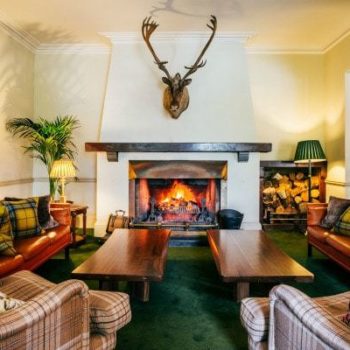
 IRELAND’S CASTLES & COUNTRY HOUSES – PART ONE
IRELAND’S CASTLES & COUNTRY HOUSES – PART ONE
by R. COURI HAY
Image Source: Travelsquire.com
Rock of Cashel
I was feeling a wee bit peckish after the early morning arrival of the six hour flight to Dublin from New York so we decided to stop for breakfast on the way to Cashel Rock. At a quaint spot called Over the Bakery near this ancient site, they served us eggs, toast, sausage and bacon all as quickly as you could get a burger at Mc Donald’s.
We were beginning an adventurous road trip around Ireland to connect with its storied past and people. Our goal: to discover as many ancient castles and historic country houses as possible in two weeks. From Dublin, we were heading south towards Sheen Falls in County Kerry, with the idea to reach County Tipperary first by mid-afternoon.
There’s nothing like a tour of a romantic castle to set the tone. In 1101, the King of Munster donated his fortress on Cashel Rock to the Church. Today, the various buildings at the site, including the Round Tower, Cormac’s Chapel, dating from 1127, and the cathedral from 1270, comprise one of the most extensive collections of Celtic art and medieval architecture in all of Europe. During the Irish Confederate Wars in 1647, English troops sacked Cashel, and Irish troops as well as the Roman Catholic clergy were massacred. Over the centuries, the two sides have made peace; Queen Elizabeth II visited Cashel during her 2011 visit to Ireland.
Sheen Falls Lodge
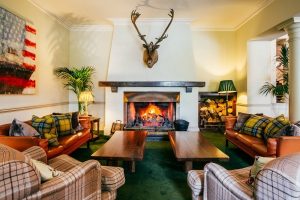
Reaching Kerry, we drove through the gates of Sheen Falls Lodge, set amid fields of lush green grass and flower gardens. Inside the five-star country lodge, a fire burned in the hearth beneath a massive set of moose antlers, and I instantly felt like I had stepped onto the backlot of Jane Eyre. That is, except for the American flag flapping out front to welcome us. Situated on 300 acres in southwestern Kerry, one of the most picturesque places in the world, the Lodge is Irish hospitality at its finest. Deer and wildlife roam the property, which boasts idyllic pastoral views. Amenities include fine dining, a world-class spa and all manner of outdoor activities, from hiking to falconry. The surrounding area was settled in the 1600s, and by 1700 there was a small cottage at Sheen Falls, incorporated today into the current lodge which was built in the early 20th century. A distinctive arched stone bridge over the falls dates from 1777, and remains unchanged to this day. The grounds are also home to several historical sites including St. Finian’s Church, ruins dating from 838 A.D. that were pillaged by Vikings, and the Famine Burial Plot, commemorating the Irish potato famine of the 1840s.
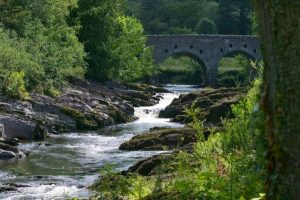
The view of the river rushing over rocks and under the ancient bridge from our room was breathtaking. The expansive space boasted long walls of windows on two sides overlooking the Falls and dressed with natty Chanel tweed-like draperies. On the other side a large terrace faced Kenmare Bay. Furnishings included a sumptuous plaid sofa with plump pillows, a writing desk and tea table facing the river. A soothing neutral palette was accented with green and rose, and floral paintings by noted artist Christine Bowen who lives and works in the area, further enlivened the setting. A late dinner in the excellent Falls Restaurant of pea soup with wild garlic and aged Irish steak at a table facing the river hit the spot. The next morning a falconer brought a van full of hawks and owls that we flew around the lawn; a grey owl named Gandolf the Wizard stole the show. We also had fun fishing for salmon in the river and for trout in one of the lakes onsite. Good news: you can cook and eat your catch. When at last it came time to move on to our next stop, I had a pang of remorse; Mr. R. Couri Hay was feeling almost at home here in this part of Ireland.
Muckross House & Abbey

There is plenty to see and do in the countryside of Kerry. The region boasts some of Ireland’s top attractions including Muckross House, a stately Tudor home that Queen Victoria visited in 1861. The inside offers a window on how aristocrats used to live along with the sad story of Maud Vincent, the one-time American owner of the property who died of pneumonia on the voyage over to see her parents. Afterward, the family donated the house and its 11,000 acres of dramatic grounds to the nation, and it became the first national park in the Republic of Ireland. The garden is stunning, with endless vistas off to a lake. We took a horse and buggy to visit the ruins of the Abbey that was destroyed by Cromwell in September 1539. Although the roof is gone, the walls are still standing and there is a tree said to be 700 years old in the center courtyard that is a miracle of nature. Also on the property is a small waterfall that’s worth the short walk.
Ross Castle
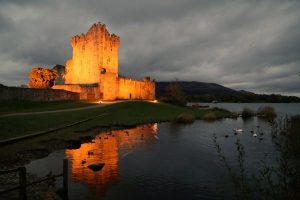
Ten minutes from Muckross is Ross Castle, built in the late 15th century. Perched on Lough Leane, with waves lapping at its walls, it would be hard to find a more picturesque spot in all of Ireland. The castle, also known as a “keep,” was among the last to surrender to Cromwell during the Irish Confederate Wars. Although it’s technically a ruin, there are several main rooms that are still intact. The most spectacular view is from the exterior looking towards the castle which is perched at the water’s edge. At night we went to Mike Casey’s The Lime Tree for an exceptional dinner of Mackerel and Sole. This attractive and reasonably priced restaurant ten minutes from the Lodge is highly recommended.
Bunratty Castle
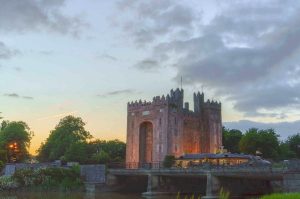
The next morning, we left Sheen Falls to make the six-hour drive to Lough Erne Resort in Enniskillen, County Fermanagh, Northern, Ireland. On the way we stopped for lunch at Bunratty Castle, in County Clare. Built in the 15th century, Bunratty is a medieval history buff’s dream and is both impeccably restored and historically accurate. There is even a fully operating medieval village surrounding the castle with everyone dressed in 15th century costume. This “folk park” consists of over 30 buildings offering workshops in things like pottery making and archery. Every night the castle serves up a medieval banquet that looks, feels and tastes just as it did when Bunratty was at the height of its glory. These “meals” are offered 365 days a year and are alot of fun, especially with a group of friends.
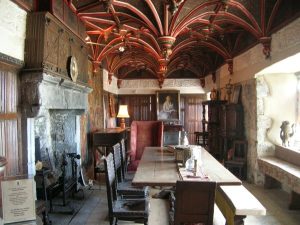
Lough Erne, A Golfer’s Paradise

Lough Erne Resort has a place in history, not because of its ancient roots or that a famous battle was fought on its lush grounds – but rather the gathering here of presidents from eight countries, including France’s Francois Hollande, Russia’s Vladimir Putin, Germany’s Angela Merkel, the UK’s David Cameron and the USA’s Barack Obama at the G8 summit in 2013. The resort is built to resemble a collection of miniature castles facing the Lough (lake).
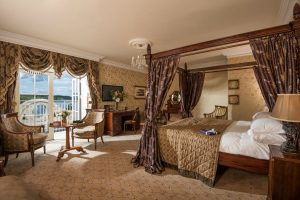
The main club house is surrounded by two world class golf courses, one designed by British pro-golfing legend Nick Faldo, a 9-time PGA tour winner, and Castle Hume, which has hosted ten Ulster PGA Championships. There is also a golf academy with a team of PGA pros led by Lynn McCool. President Obama didn’t have time for golf during the summit, but asked McCool to help him with his swing on his next visit.
Facing the lake are charming, turreted lodges; we stayed in a two-bedroom with its own kitchen, useful if you are inclined to cook. After a round on the renowned links, we dined in the resort’s celebrated Catalina Restaurant under the direction of Chef Noel McMeel, an affable Irish gentleman who used to work at Le Cirque in NYC. Try the crab appetizer, the lamb “five ways,” and the Blackrock stone bass. There’s even a lovely sorbet between courses.
Game of Thrones
After a second day of golf, we went to the town of Enniskillen for a pint at Blakes of the Hollow, one of the oldest pubs in Ireland, which was recently voted the best pub in Northern Ireland. It doesn’t hurt that they can also boast that they have a door from the set of Game of Thrones; scenes of the show were filmed in the woods a forty-five minute drive from the pub in Belmore Forest.
Next door to Blakes is Enniskillen’s most charming restaurant Café Merlot which is actually underground with impressive vaulted ceilings. If you’re a big group they’ll put tables together but if you’re simply two, ask for the raised table by the wine cellar overlooking the bar. It’s private and you can still see and hear all the action in this authentic spot. Try the sumo fries with spicy dips, the Peking Duck that falls off the bone and absolutely get a pot of vegetables; these local jewels of peas, carrots, mushrooms, onions and other delicious nuggets dripping in a succulent broth stole our culinary heats.
Florence House
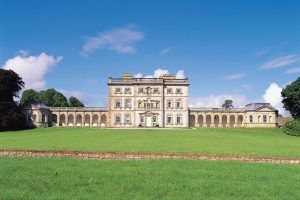
We finally left our putters behind and went sightseeing. Technically, Florence Court, built by John Cole Esq. and named after his wife Florence Bourchier, isn’t a castle; it’s a great country house with over 1,000 acres of parkland and a formal rose garden. The day we were there, the BBC was filming their series Blandings. It was a treat to see sheepdogs herding their flock on the lawn in front of this stately home. The interiors are splendid and beg to be discovered.
Enniskillen Castle
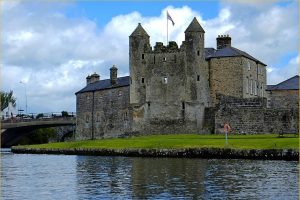
Back in the town of Enniskillen is Enniskillen Castle situated on the edge of the River Erne. They’ve just completed their new museum, and it’s a gem. In the castle’s barracks you open a series of doors to reveal first a treasure room filled with antique silver from the 17th century, then a second with mementos and medals from World War II. There’s not much left of the castle itself other than a picturesque wall and turret that flies the English flag. This is a terrific spot for photography of all sorts, from selfies to jealousy-inspiring Instagram pics.

